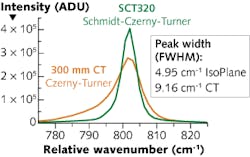The Schmidt-Czerny-Turner (SCT)-based, single-stage IsoPlane spectrograph from Princeton Instruments (Trenton, NJ) has zero astigmatism at all wavelengths across the entire focal plane. While the 802 cm-1 Raman shift band of cyclohexane measured with a traditional Czerny-Turner spectrograph has a peak width of 9.16 cm-1, the same peak measured with an IsoPlane under similar conditions has improved resolution with a peak width of 4.95 cm-1. And because SCT spectrographs have high fluence (more photons focused on fewer pixels), improved signal-to-noise ratio is demonstrated by the fact that the cyclohexane peak height measured with an SCT IsoPlane is almost twice that measured with a CT spectrograph.
When an IsoPlane is interfaced to a low-frequency XLF-CLM Raman spectroscopy module from Ondax (Monrovia, CA), which uses volume holographic gratings (VHGs) as Rayleigh line filters giving peaks as close as 10 cm-1 from the Rayleigh line, measurement of low-frequency Raman spectra is possible. While most spectrographs can detect Raman shifts from 200 to 4000 cm-1, detection of shifts from 10 to 200 cm-1 and closer to the Rayleigh line often requires expensive and complex triple monochromators to reject most of the Rayleigh scattering. Measurements of the low-frequency spectral of several amino acids using the IsoPlane VHG system found the expected number of peaks in agreement with the literature, as well as many additional peaks that appear to be new to science. Contact Brian Smith at [email protected].

